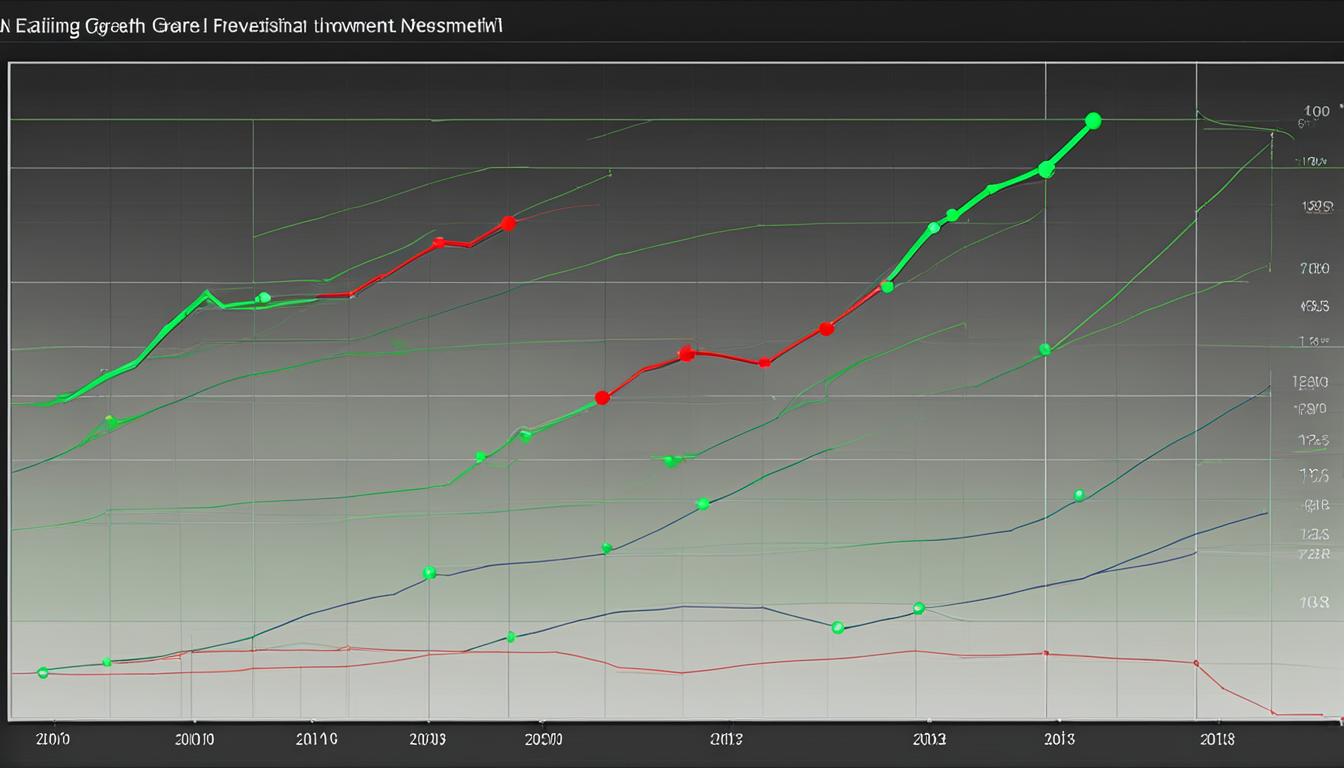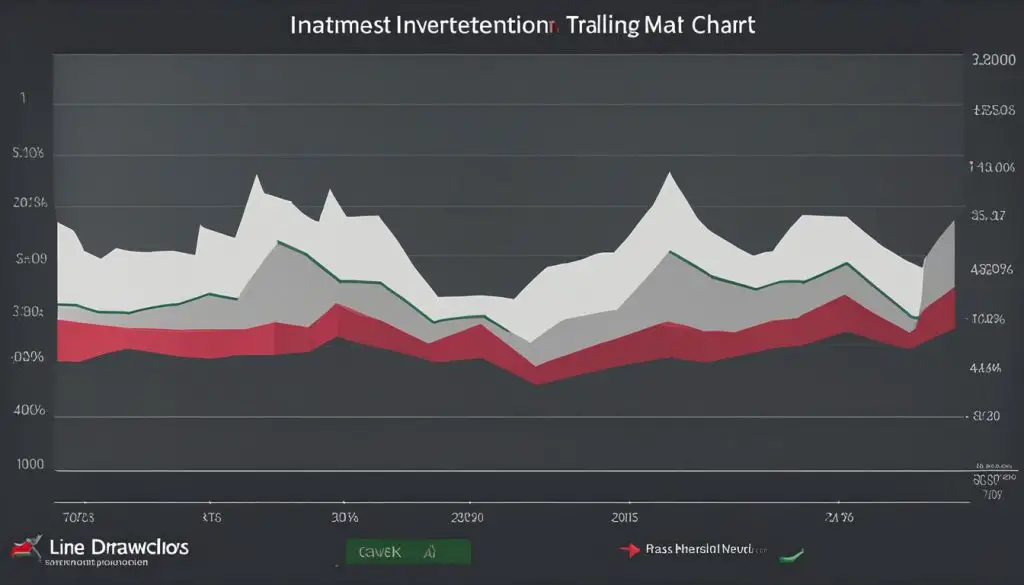In the realm of funded trading, the term trailing drawdown bears significant weight in how traders manage risk and protect their gains. Grasping the trailing drawdown meaning is crucial for investors who partake in trading through platforms with capital allocation from third-party companies. These entities employ trailing drawdown calculation methods as a unique form of stop-loss, not only to safeguard their interests but also to encourage prudent risk management among traders.
The concept of a trailing drawdown evolves with the trader’s success. Unlike classical risk measures, this form maintains a baseline that can move in sync with the account’s balance, rising to secure profits yet holding firm during downturns. Breaching this threshold can have serious repercussions, including the potential termination of the trading account. Through such stringent trailing drawdown risk management procedures, funded account providers can efficiently gauge a trader’s aptitude in sustaining profitability while keeping losses within manageable bounds.
Introduction to Trailing Drawdown in Funded Trading
In the arena of funded trading, the concept of trailing drawdown has emerged as a vital risk management strategy. Its role extends beyond just safeguarding profits; it is equally imperative in the realm of account evaluation for traders aspiring to responsibly handle greater sums of capital.
Origin and Definition of Trailing Drawdown
The term ‘trailing drawdown’ refers to a dynamic form of risk management that funded account providers introduced to the financial trading landscape. By design, this mechanism mirrors the behavior of a trailing stop loss which elevates alongside accruing profits, yet remains unaffected during downturns. This technique essentially encapsulates gains while precluding the drawdown level from receding, thus fortifying the trader’s position against adverse market swings.
Role in Funded Account Providers’ Evaluation
Revered funded account providers, including entities such as Leeloo, Earn2Trade, and UProfit, mandate the observance of trailing drawdown thresholds as part of their trader assessment protocols. The mechanism plays a dual role, enabling providers to audit risk management aptitude while offering traders a clear benchmark for fiscal prudence. Alignment with these standards is not only crucial to surmount the evaluation phase but also integral to embedding robust trailing drawdown risk management at the core of the trader’s tactical framework.
| Funded Account Provider | Evaluation Drawdown Policy | Funded Account Drawdown Policy | Real-Time or End-of-Day Adjustment? |
|---|---|---|---|
| Leeloo | Starts with account balance, adjusts with profits | Same as evaluation, with potential for greater capital | Real-time based on unrealized profits |
| Earn2Trade | Predefined drawdown limit, increases with account milestones | Relaxed limits compared to evaluation phase | End-of-day adjustment |
| UProfit | Fixed drawdown level during evaluation | Dynamic adjustment after passing evaluation | End-of-day for evaluation, real-time for funded accounts |
How Trailing Drawdown Works in Practice
The dynamics of a trailing drawdown are pivotal in the realm of funded trading, serving both as a measure of a trader’s risk management prowess and as a safeguard to ensure the optimal leveraging of trading profits. Its automation and responsiveness to a trader’s activities provide a systematic approach to capital preservation.
Understanding the Mechanism
A trailing drawdown functions akin to a protective shadow over a trader’s capital, one that extends during moments of financial success and holds steady during times of loss. When a trader garners a profit, for instance, the algorithm governing the trailing drawdown propels its threshold upward, in perfect step with the increased account balance. This methodology does more than record progression—it fortifies the trader’s capacity to endure market fluctuations by effectively securing earned gains.
Impact of Profit and Loss Trades on Trailing Drawdown
Profits and losses impart a distinct swing to the needle of the trailing drawdown gauge. Upon securing a profit, a trader not only bolsters their account balance but also simultaneously elevates their drawdown limit. This upward mobility is poised to absorb both the ebullient highs of $2,000 profits and the despondent lows of $1,000 losses, demonstrating a risk management tactic that doesn’t thereby flinch or falter in the face of adversity.
| Trade Result | Account Balance Change | Trailing Drawdown Adjustment |
|---|---|---|
| Profit of $2,000 | + $2,000 | Threshold moves up |
| Loss of $1,000 | – $1,000 | No change |
The trailing drawdown’s resilience in the face of a loss is a testament to its primary role – to ensure that previous trading profits remain untouchable and to establish a firm foundation for recovery without surrendering prior gains. It’s this characteristic that underscores the allure of funded trading, where management of both success and risk are equally championed.
Trailing Drawdown Calculation: A Step-by-Step Guide
Grasping the concept of trailing drawdown calculation is essential for traders aiming to manage their risk effectively. To illuminate the process, this step-by-step guide will dissect how drawdown limits escalate in harmony with a trading account balance, ensuring traders can maintain control over their maximum drawdown.
The initial step in this pivotal risk management strategy commences with establishing a drawdown threshold, which is determined by subtracting the trailing drawdown amount from the existing account balance. As profitable trades occur, this threshold progressively ascends, parallel to the growth of the account balance, yet it staunchly remains fixed in the face of losing trades.
Leveraging examples from renowned trading platforms, we can delineate the differences in calculations. Platforms like TradeDay assess drawdown based on the final account balance at day’s end. Conversely, Leeloo integrates unrealized profits within the trading day to adjust the drawdown limit, granting traders a real-time view of their risk exposure.
- Establish starting drawdown limit based on initial account balance
- Increase the limit proportionately with each profitable trade
- Maintain the drawdown limit despite any subsequent trading losses
- Monitor the relationship between account balance growth and drawdown adaptation
| Trade Result | Account Balance After Trade | Drawdown Limit Before Trade | Drawdown Limit After Trade |
|---|---|---|---|
| Profitable Trade | $102,000 | $97,000 | $99,000 |
| Loss Trade | $101,000 | $99,000 | $99,000 |
| Profitable Trade | $104,000 | $99,000 | $101,000 |
By methodically following these principles, traders can safeguard their capital, ensuring they never exceed the maximum drawdown level permitted by their trading strategy and the parameters set by their platform. Accurate trailing drawdown calculation affords a buffer against volatile market swings, fortifying a trader’s position in the face of uncertainty.
Trailing Drawdown as a Risk Management Tool
The tenets of robust risk management in trading hinge on the adept use of tools like trailing drawdown to navigate through volatile markets. Traders should not only focus on the drawdown, instead they should have a look on calculating the risk of ruin as well. Recognizing the oscillating nature of trading, trailing drawdown stands out, not merely as a concept but as a strategy sculpted from the need to subdue the wild swings of trading fortune while safeguarding one’s capital. By implementing a fluid yet firm threshold on trading risk exposure, this form of drawdown control allows traders to temper their market engagement with a keen sense of both opportunity and restraint.
Evolving Risk Management with Trailing Drawdown
By embracing trailing drawdown in their risk management repertoire, traders engage a dynamic safeguard against the tumult of the markets. This mechanism adjusts either in tandem with real-time market fluctuations or adapts after the market closes, reflecting an evolution in managing drawdown. It’s not static; it’s strategic, subtracting or contributing to the traders’ buffer zone as dictated by their trading efficacy. With each rise in their account balance, so too lifts their safety net, tailoring their trading risk exposure to their living, breathing portfolio performance.
The Importance of Managing Drawdown Limits
When it comes to trading capital preservation, success is measured in the ability to endure and adapt. Managing drawdown effectively fences in potential financial forays into dangerous territories, ensuring that traders are not just guarding against losses but are setting the stage for sustainable growth. The ebb and flow of a trading account’s balance become less about avoidance and more about intelligent engagement. Traders who master the art of managing drawdown limits transform risk from an adversary into a companion—one that walks hand-in-hand with opportunity on the path to market mastery.
FAQ
Trailing drawdown is a risk management measure that acts as a dynamic stop-loss for a trading account. It’s designed to protect capital by setting a threshold that increases with the account balance as profits are made but does not decrease with losses. It is crucial for ensuring a trader’s consistency and protecting against excessive losses.
The trailing drawdown is calculated by setting an initial threshold below the trading account balance. As the account balance increases due to profitable trades, the drawdown limit rises accordingly, locking in profits and increasing the trader’s ‘buffer’ against future losses. This limit is maintained or suspended at its level during losing trades, ensuring that the drawdown does not move downward.
Trailing drawdown is a critical component in the evaluation process by funded account providers. It assesses a trader’s ability to follow risk management rules and manage capital effectively. Traders must adhere to the trailing drawdown limits to demonstrate their skill and qualify for managing larger capital allocations provided by funding firms.
In practice, trailing drawdown adjusts automatically based on the trader’s performance. If a trader earns profits, both the account balance and the trailing drawdown threshold increase, providing more room for future trades. If a loss occurs, the account balance decreases, but the trailing drawdown stays at its recent highest level or stops at a predefined level, thus not increasing the risk after a loss.
Profit trades will increase the trailing drawdown limit along with the account balance, effectively locking in gains and expanding the trader’s risk threshold. Loss trades will lower the account balance, but the trailing drawdown limit remains unchanged. This ensures that losses do not further increase risk exposure and gives the trader a stable platform for potential recovery.






